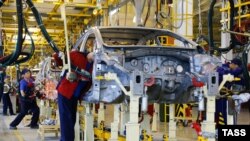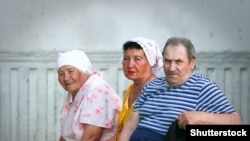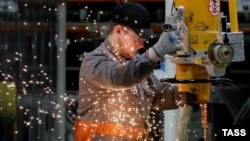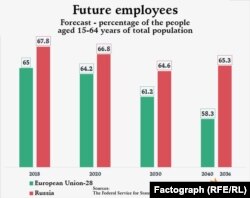Russia’s Federal State Statistics Service (Rosstat) reported in early 2018 that Russia’s working population is 82.3 million people. Such numbers were last reported in 1979. The country’s working population peaked in 2006, at 90.16 million people.
With the retirement age in Russia now 60 years old for men and 55 for women, the country’s labor force is 56% of the total population – exactly the same as it was in 1970.
However, Russia’s retirement age is much lower than in most other European countries. And Maxim Topilin's statement, which at the bottom line is true, leaves out an important reason. And it comes amid an unpopular push to raise the retirement age
In 2013, the median retirement age for the 28 countries of the European Union was 64.5 years old for men and 63 for women. The EU forecasts this will rise to 65.2 years for men and 64.4 for women by 2020.
The average retirement age for the 35 countries of the Organization for Economic Cooperation and Development (OECD), which includes the world’s most industrialized economies, is close to the European average. In 2016, the average OECD retirement age was 64.3 years for men and 63.7 for women.
Both the OECD and the European Union define the employable population as being people from 15 to 64 years old. Interestingly, the size of the employable population hasn’t changed a lot in the European Union over last 50 years. On average, for the G7 countries, as well as the 35 OECD and 28 European Union countries, the employable population has remained at two-thirds of the whole population.
We find there has been a decline in Russia’s working age population. But the assertion that there is an imbalance in the labor market is misleading – at a time when the Putin government is raising the retirement age.
According to Russia’s statistics, the proportion of the employable population to the total population is much lower. If, however, we calculate it based on the standards of the OECD and the EU – that is, looking at ages 15-64 -- that the proportion is actually much higher.
Moreover, if we take the current forecast for the European Union for the coming decades and compare it with the estimates made by Rosstat for the period up to 2036, it becomes obvious: the proportion of the population aged 15-64 in Russia will continue to be much larger than in Europe. And this gap will even widen:
But, in general, based on the current retirement age, the share of the working-age Russians, which peaked in 2006 (almost 63%), will, according to Rosstat’s forecast, be significantly lower in 20 years than it was in the late 1980's. Moreover, this reduction will occur at the same time the share of young people in the total population also drops while the share of pensioners increases sharply.
Russia’s government recently announced that, starting next year, the retirement age for men will gradually rise to 65 years by 2028, while the retirement age for women will gradually rise to 63 by 2034.
The push to raise the retirement age emerged from the Putin government, despite his statement in 2005 that raising the retirement age was out of the question due to low life expectancy and high mortality rates. His press secretary, Dmitry Peskov, speaks of demographic and economic changes in the ensuing 13 years.
And it appears to be unpopular. Despite the Russian football team’s success in the World Cup, two polls showed President Putin’s approval rating slumping about five or six percent during the games.
Adapted from Factograph.info.



